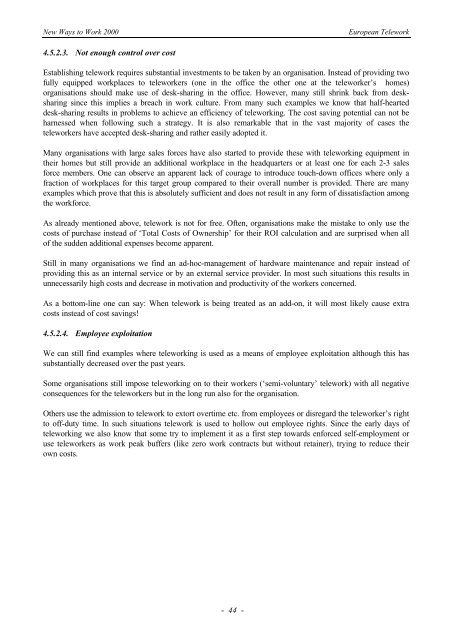eWORK 2000 - European Telework Week
eWORK 2000 - European Telework Week
eWORK 2000 - European Telework Week
- No tags were found...
You also want an ePaper? Increase the reach of your titles
YUMPU automatically turns print PDFs into web optimized ePapers that Google loves.
New Ways to Work <strong>2000</strong><strong>European</strong> <strong>Telework</strong>4.5.2.3. Not enough control over costEstablishing telework requires substantial investments to be taken by an organisation. Instead of providing twofully equipped workplaces to teleworkers (one in the office the other one at the teleworker’s homes)organisations should make use of desk-sharing in the office. However, many still shrink back from desksharingsince this implies a breach in work culture. From many such examples we know that half-hearteddesk-sharing results in problems to achieve an efficiency of teleworking. The cost saving potential can not beharnessed when following such a strategy. It is also remarkable that in the vast majority of cases theteleworkers have accepted desk-sharing and rather easily adopted it.Many organisations with large sales forces have also started to provide these with teleworking equipment intheir homes but still provide an additional workplace in the headquarters or at least one for each 2-3 salesforce members. One can observe an apparent lack of courage to introduce touch-down offices where only afraction of workplaces for this target group compared to their overall number is provided. There are manyexamples which prove that this is absolutely sufficient and does not result in any form of dissatisfaction amongthe workforce.As already mentioned above, telework is not for free. Often, organisations make the mistake to only use thecosts of purchase instead of ‘Total Costs of Ownership’ for their ROI calculation and are surprised when allof the sudden additional expenses become apparent.Still in many organisations we find an ad-hoc-management of hardware maintenance and repair instead ofproviding this as an internal service or by an external service provider. In most such situations this results inunnecessarily high costs and decrease in motivation and productivity of the workers concerned.As a bottom-line one can say: When telework is being treated as an add-on, it will most likely cause extracosts instead of cost savings!4.5.2.4. Employee exploitationWe can still find examples where teleworking is used as a means of employee exploitation although this hassubstantially decreased over the past years.Some organisations still impose teleworking on to their workers (‘semi-voluntary’ telework) with all negativeconsequences for the teleworkers but in the long run also for the organisation.Others use the admission to telework to extort overtime etc. from employees or disregard the teleworker’s rightto off-duty time. In such situations telework is used to hollow out employee rights. Since the early days ofteleworking we also know that some try to implement it as a first step towards enforced self-employment oruse teleworkers as work peak buffers (like zero work contracts but without retainer), trying to reduce theirown costs.- 44 -








